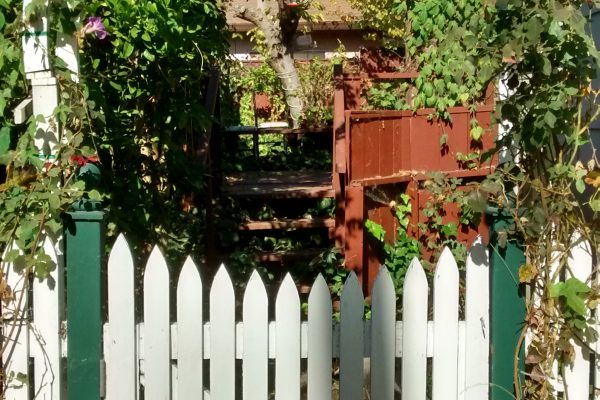By JEFF ROUBAL
Martinez News-Gazette Columnist
Vivian and I take great joy in our garden. We love to try new plants and new arrangements. It is a Darwinian garden. If some of the new plants fail, that’s because they were not meant to be. It is all about survival of the fittest. Sometimes weeds are the fittest but they don’t count because we didn’t plant them.
I’ve been planting different kinds of trees to give the landscaping a multi-layered effect. I planted a lemon tree in the front yard that grew really well. In the backyard, I put a plum and an apricot.The plum tree promptly died so I replaced it with an apple tree which also died. Darwin was at work. The apricot tree took several years to grow but now produces beautiful apricots. We also planted an orange tree and a tangerine tree which are so far languishing. I also planted one blueberry bush which yields 10 blueberries every year. In the front yard, I planted a mandarin orange tree which is just now starting to take off. Last year we harvested six Mandarin oranges.
Vivian and I go round and round about the garden. She likes to to put in flowers, succulents, and other useless things. I prefer edible plants. As long as you’re going to grow something, it might as well be good to eat. Every year we get artichokes. I’ve had some success growing tomatoes, though not recently. Many years ago I planted mint and now it randomly pops up all around the garden.
About ten years ago I was looking for a tree to fill a spot on the west side of the house. Our citrus plants had done well so that seemed to be the ticket. A lime tree was on sale for $19 at Home Depot. It seemed like the perfect thing to replace our worm composting bins that used to be outside the kitchen window.
We had roughly 10,000 worms in the four bins. I used to tell our nieces and nephews that each one had a name but it was hard to remember them all. We faithfully fed our worms vegetable peelings and table scraps for more than ten years. They faithfully provided us with rich fertilizer. Did you know that Red Wigglers can eat half their body weight in food every day? Worms spend all their time eating and reproducing. I doubt they sleep. Under ideal conditions, two worms can multiply to 10,000 in one year. When Republic Services started accepting food scraps in the green waste bin five years ago, I set the worms free and gave away our composting bins.
The lime tree was planted right where our worms had worked for years enriching the soil. “This is going to be great,” I thought but nothing happened for the first few years. The tree was shaded by a wall of ivy between our house and the neighbor’s. Without the sun, our little tree barely reached three feet tall. I had to stand on my tiptoes leaning over the kitchen sink to see it every morning when making coffee.
Three years ago, our neighbor got ambitious one weekend and tore down all the ivy. The difference was dramatic and immediate. The lime tree shot upward two feet in a year. A year ago, we put in a new fence along the west side of the house but the lime tree was already taller than the 6-foot fence so no longer shaded.
It continued to rise magnificently. Last winter I looked proudly out my kitchen window (on flat, bare feet) at a very healthy twelve-foot tree. Unfortunately, it was all leaves. I mentioned this to my mother one night and she advised spreading coffee grounds. It worked.
One morning in April, I detected tiny white flowers and excitedly showed Vivian but she was unconvinced. The flowers disappeared and that was the end of the excitement until a month later when I was sipping coffee and noticed a little green marble near the end of one tree branch. Could it be? Yes! The tree finally had a fruit. The little marbles grew and grew until there were two, then four, then ten. In August, debate started about when to pick the fruit. How does one tell if a green lime is ripe? I got a ladder and climbed up into the tree to squeeze the limes. I tugged gently at each one but all were firmly attached so we decided to wait.
Last weekend I finally picked the two biggest ones. They were dark green and each about the size of a baseball. My sister-in-law was visiting so it was the perfect time to show off our newest variety of produce. Brenda had already picked a half dozen lemons to hand-carry back to Seattle where home-grown citrus is considered a novelty in her neighborhood. Fresh limes would be the coup ‘de gras.
The two limes were pliant to the touch and very fragrant — good signs. They were beautiful inside. Bright green and juicy centers with a thin, dark green outer skin. The aroma was pungent, citrusy, and tangy.
I made three celebratory glasses of ice water with several lime slices and one cocktail cherry for Vivian, her sister, and myself. We clinked glasses not knowing about the big surprise.
Our limes were extremely bitter. Vivian described the flavor as, “Nasty!” An hour later, she complained, “I can’t get that taste out of my mouth.”
Not sure what went wrong, I consulted my trusty friend Google. Turns out that we had grown a Kaffir Lime tree (Citrus hystrix). I learned with dismay that the fruit of the kaffir lime tree is not eaten. It’s too bitter. The leaves of the Kaffir Lime tree are, however, considered a delicacy in Asian cuisine. Chefs in Thailand (where it is called Makrut), Malaysia, Laos, and the Philippines use Kaffir leaves whole, like bay leaves, in soups and sauces. They also use slivered Kaffir leaves in rice and stir fried dishes. The leaves are renowned for their delightful, citrusy, aromatic flavor.
I could have been eating delicious leaves for ten years instead of waiting for fruit! On the bright side, Google says that Kaffir limes make excellent shampoo, laundry detergent additive, household cleaner, and insect repellant. That sounds like a fun project for next week. For now, I am going to cut back on the coffee grounds so we don’t get too many.




